In Milan, I visited one of the most macabre churches I have ever entered, the Sanctuary of San Bernardino alle Ossa, decorated almost entirely with human bones. For this reason, this article may offend your sensibilities, as it features photographs of the chapel. However, seeing off the tourist attraction circuit is one of Milan’s curiosities.
Table of Contents
The Church of San Bernardino alle Ossa in Milan
The Ossuary of San Bernardino alle Ossa is inside the church of the same name. The façade of the Church of San Bernardino alle Ossa presents a characteristic 18th-century Baroque style, in stark contrast to the adjacent Basilica of Santo Stefano Maggiore. The church’s bare façade is a deliberate choice, referring to the former hospitals of Santo Stefano alla Ruota and San Barnaba in Brolo, part of this complex. Historically, hospitals often represented places associated more with death than with healing, and the simplicity of the building reflects this deep historical connection.
PLAN YOUR TRIP TO MILAN
Before you go, buy the Milan Official City Pass online to enter the city’s top museums, including the Pinacoteca Ambrosiana, the Science and Technology Museum, and the Triennale. It also grants you access to the Duomo terraces and free rides on trams, buses, and the metro lines.
If you’re travelling with children or short on time, book in advance the hop-on hop-off sightseeing bus tickets with audio guide to see Milan in one day, stopping at main attractions like Brera, the Duomo, Galleria Vittorio Emanuele II, and La Scala Theatre.
While travelling in Italy, you can stay connected with family and friends using Holafly eSIM, enjoying unlimited data at 3G, 4G, and LTE speeds. Additionally, don’t forget to get Heymondo travel insurance for worry-free adventures.
Tuttavia, una volta all’interno, la Chiesa di San Bernardino alle Ossa appare come una chiesa tradizionale, con l’eccezione di un altare laterale adornato da figure bibliche in plastica, dalle fattezze decisamente kitsch. L’effetto è così surreale che può suscitare il sorriso, con figure di plastica luccicante trafitte da dardi e bambole vestite con ornamenti dorati che creano un contrasto inaspettato all’interno di questo austero contesto.
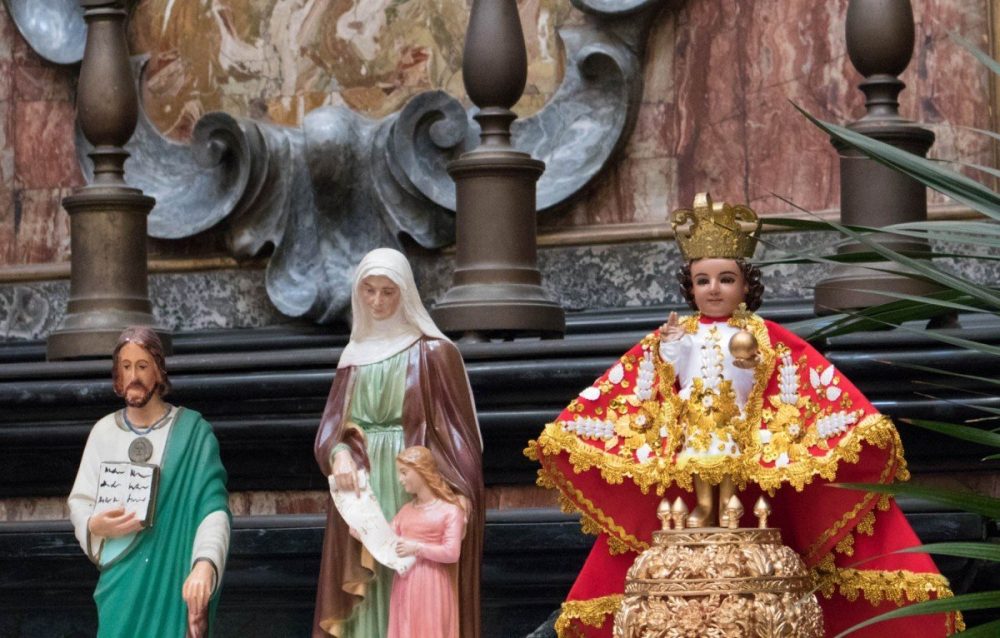
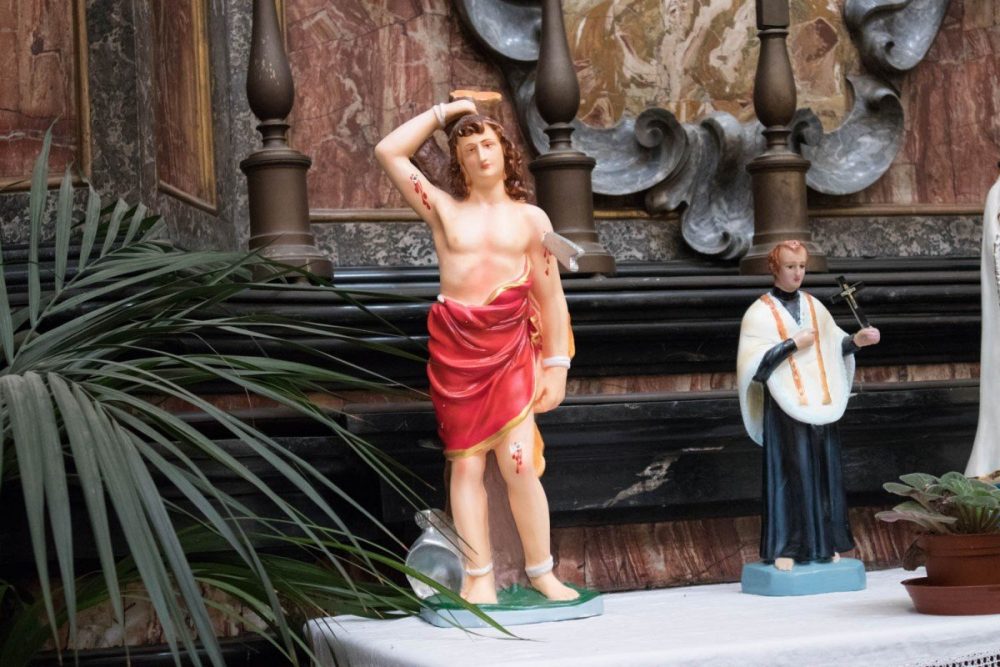
The ex-voto hallway
After visiting the church, to reach the ossuary, you have to pass through a narrow corridor with peeling walls painted pale yellow and covered with dusty votive offerings, some protected by nets or glass cases. These objects, often metal hearts, are left by the faithful as thanks for graces received from the saints.
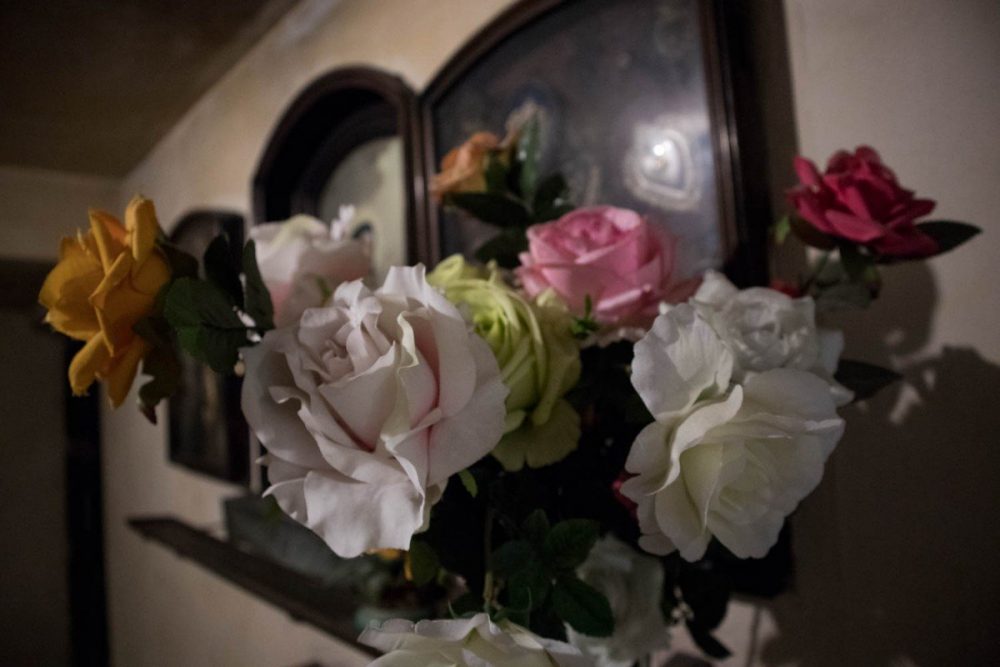
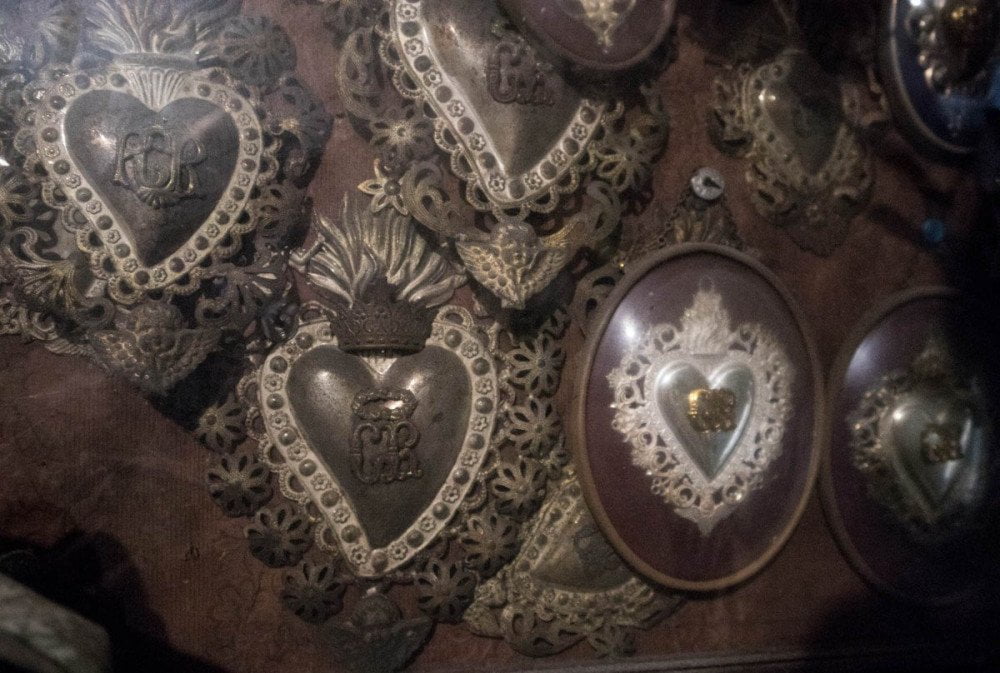
How to reach the Ossuary Chapel from the Church
The Ossuary of San Bernardino alle Ossa chapel is at the end of the narrow corridor of votive offerings. Once inside, you will find an unusual decoration of human remains. Femurs, skulls and other bones creatively create shapes such as crosses or rococo-style motifs.
The visual impact is surprising and disturbing, all the more so because these are authentic human remains from centuries past, not artificial replicas. The fresco on the vaulted ceiling offers the only breath of ‘fresh air’ (figuratively speaking) in this context, depicting a soul ascending to heaven. The ambience conveys an aura of gloom and death, evoking a profound reflection on mortality and the transience of life.
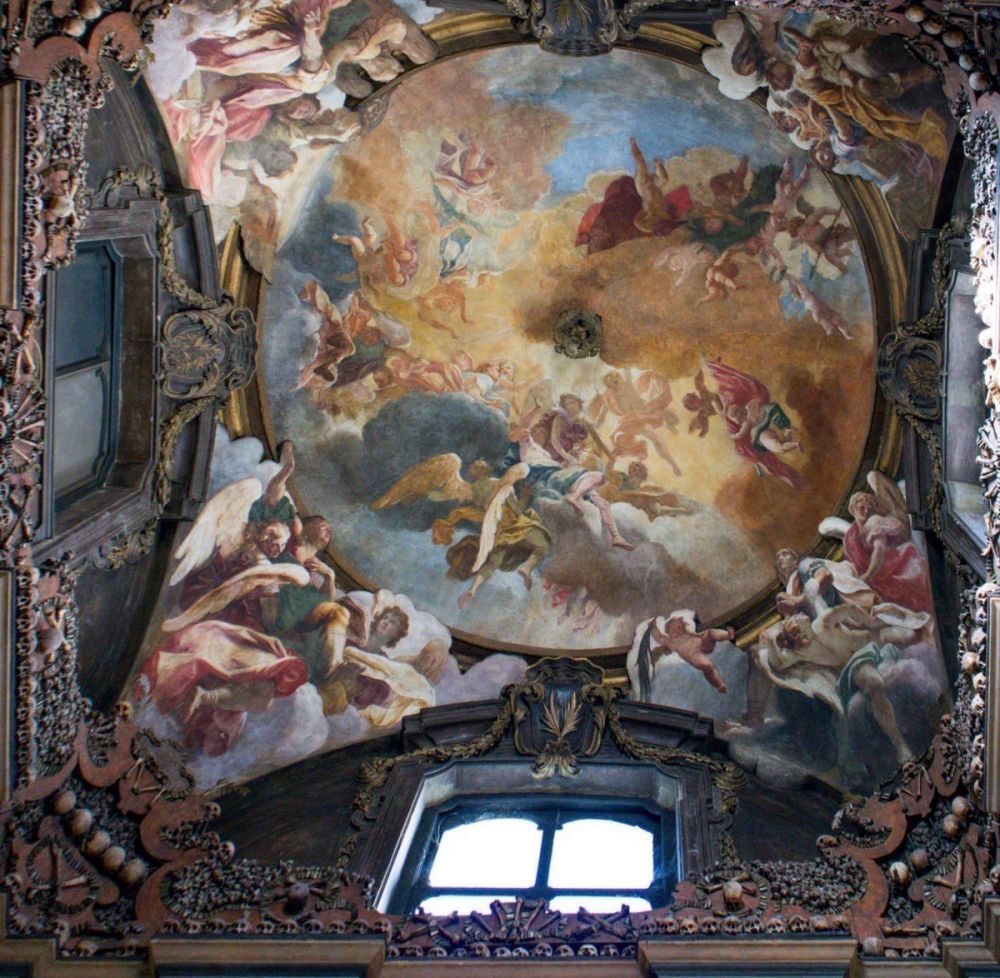
The remains in the ossuary of San Bernardino alle Ossa: history and legend
Some famous legends claim that the human remains displayed in the ossuary belong to Catholic Christians killed by Arian Christians in the 4th century. Or from the plague victims of 1630 that Alessandro Manzoni recounts in Promessi Sposi.
Historically, however, it is well established that the bones that make up the unique decoration of the Ossuary of San Bernardino alle Ossa come mainly from the sick who died in the hospital, from the friars who worked there, from aristocrats and canons of the basilica of Santo Stefano, but also from prisoners and those condemned to death. In particular, some showcases contain the skulls of those sentenced to death.
The ossuary stored bones from the cemetery of both hospitals of Santo Stefano alla Ruota and San Barnaba in Brolo. To make room for new bodies, bones from previous burials were periodically exhumed and collected in the ossuary.
However, the medieval ossuary must have corresponded to a storehouse; there was yet to be the Rococo decoration you can see today in the Ossuary of San Bernardino alle Ossa. The renovation that led to this ‘work of art’ took place only thanks to the collapse of the bell tower of the nearby St. Stephen’s Basilica.
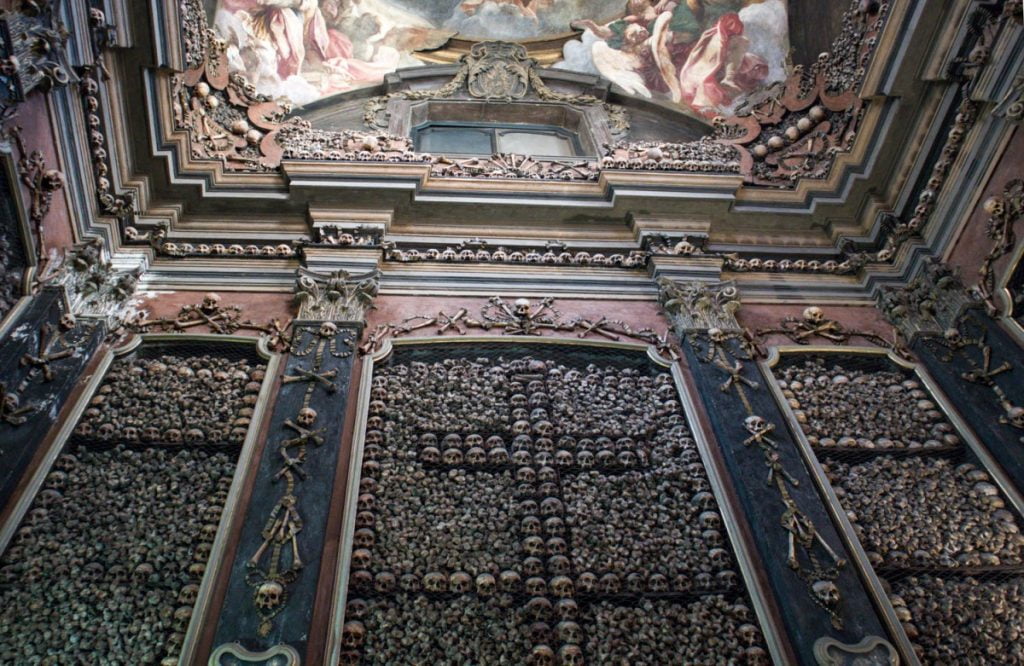
Curiosities about the Sanctuary of San Bernardino alle Ossa in Milan
Due to its characteristics, the Sanctuary of San Bernardino alle Ossa has given rise to several legends and curiosities. First, there are many correlations between the Confraternity of the Disciplini and the Portuguese descendants of Christopher Columbus to the Church of San Bernardino alle Ossa. Second, due to the presence of human bones in the decorations, the ossuary is similar to the famous Capela dos Ossos in Evora, Portugal. Still, the most lugubrious element is the legend that links it to a suggestive danse macabre.
The Confraternity of the Disciplines
Disciplini, a medieval confraternity known for their self-flagellation habits, built the Ossuary of San Bernardino alle Ossa in its present form. This name derives from their strict discipline in life.
The Disciplines wore unique clothing, a habit opened on the back with a hood that left only the eyes uncovered, to show the scars of the self-inflicted whippings. This brotherhood had a deep connection with the cult of the dead, and the bodies of the brethren were slowly mummified in the church basement, called putridarium.
Disciplines had a peculiar relationship with death, so they chose this mournful decoration for their ossuary. Its intention was to impress the faithful and communicate the transience of earthly life to them, serving as a memento mori, a constant reminder of mortality.
The Portuguese descendants of Christopher Columbus
Popular legend is that buried in the Ossuary of San Bernardino alle Ossa are two Portuguese descendants of Christopher Columbus, Peter Antonio and John of Portugal Colon Counts of Puela and Veragua. However, this raises questions because, as you can discover by visiting the Galata Museo del Mare in Genoa, Christopher Columbus was not of noble origins.
The Genoese navigator is only depicted as noble in later iconographic representations when, in fact, he was only an expert navigator. On the contrary, the Colon family buried here must have been dignified to have the privilege of keeping their bones here. However, they may also have been navigators, colonists or explorers because the family coat of arms bears the motto ‘Colon gave the New World to Castile and Leon’.
Capela dos Ossos in Evora
Another Portuguese who linked his personal history with that of the Sanctuary of San Bernardino alle Ossa was King John V. During a visit, he was so impressed that he wanted a copy in Portugal, which is why the famous Capela dos Ossos in the Igreja de Sao Francisco in Evora, near Lisbon, was decorated with human bones in 1783.
La danse macabre
The last legend linked to the Ossuary of San Bernardino alle Ossa relates to the danse macabre, or dancing skeletons visible in many works of art from the past, a trendy theme in the Middle Ages. Indeed, every year on 2 November, the bones of a little girl buried to the left of the altar come alive and drag the other skeletons into a spectral dance so noisy that people from outside the church can hear the ticking of the bones.
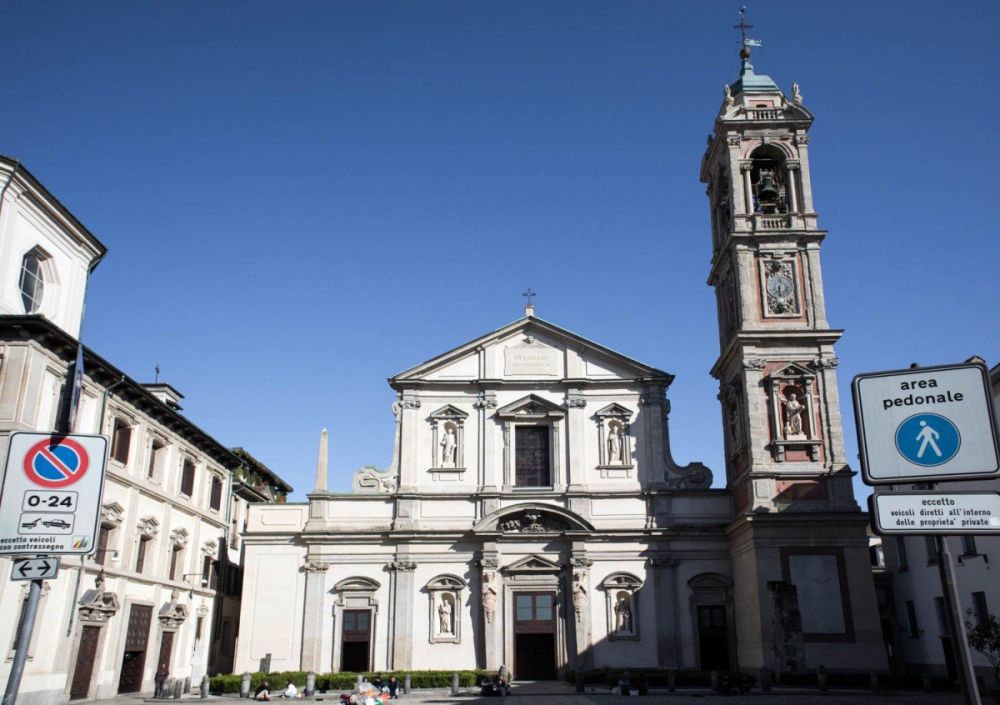
Practical information for visiting San Bernardino alle Ossa in Milan
The Sanctuary of San Bernardino alle Ossa is in Milan. It is part of Milan’s adjacent Church of San Bernardino alle Ossa and the Ospedale Maggiore complex. To visit the ossuary, you must first enter the church of the same name, located to the left of the nearby Basilica of Santo Stefano Maggiore, then a narrow corridor to the left of the entrance where the ex-votos of the faithful are displayed.
The Church of San Bernardino alle Ossa has a simple façade reminiscent of the Baroque style of the 18th century, characterised by numerous windows and minimal decoration, in stark contrast to traditional Catholic churches, such as the nearby Basilica of Santo Stefano Maggiore. You can get there comfortably by public transport. In Milan, Google Maps works well for mapping metro, bus and tram routes.
Santuario di San Bernardino alle Ossa
Piazza Santo Stefano
20122 Milano
Where to stay in Milan
Milan is one of Italy’s largest cities and, for this reason, offers every possible type of accommodation. Park Hyatt Milano is the most luxurious hotel in the heart of the fashion district in Milan. It’s near the Cathedral and La Scala Theatre, making it an excellent tourist location. For cheaper yet elegant accommodation, try Aparthotel Meneghino, within walking distance of Milan Cathedral and the Milan Fashion District. B&B Le Dimore Suites Milano is also a great option with a terrace and views of the inner courtyard.
The Ossuary of San Bernardino alle Ossa, with its decoration made of human bones, is one of Milan’s most unique attractions. Write in the comments if you already know the Sanctuary of San Bernardino alle Ossa and if this place has intrigued you because of its eerie atmosphere or historical and religious interest.
